Patents, copyrights, and other forms of intellectual property help protect the assets and creations of individuals, companies, and organisations. The patent process is an important part of protecting these items as it grants the patent owner the greatest rights to their inventions or creations. This blog series will explore the patent process in detail and how it can be used to protect a client’s asset. The patent process generally involves filing paperwork with the national inventors’ office or similar agency in a country that grants patents. This paperwork must include detailed descriptions of an invention or creation that is being patented so that it can be properly protected from theft or duplication by competitors. Once approved, this document will provide legal protection for the item for a certain amount of time as determined by local laws.
Along with patents there are also copyrights and trademarks which provide additional protection for an inventor’s work but may not be enough to fully protect their intellectual property from infringement by competitors.
A patent is a government grant of property rights to inventors and owners of inventions, giving them exclusive rights over the invention for a limited period. This means that only the inventor or patent holder has legal authority to make, use, or sell an invention. Trademarks protect words, phrases, symbols and designs that identify a brand or product from infringement by third parties.
Patents are a form of intellectual property protection that inventors and innovators use to protect novel features of their inventions or products. The patent process begins with the filing of a provisional patent application, which is essentially a placeholder for the invention. After filing the application, the inventor must provide drawings, evidence and reasons why his/her invention has unique features and commercial prospects. If accepted by the Patent Office, they grant legal protection to an invention or idea for a certain period of time. This includes barring third parties from producing or selling similar products without permission from its inventor. The process is complex and applicants should seek advice from experienced professionals when filing applications for their inventions. A provisional patent application is the first critical step for many inventors in protecting their ideas and inventions.

Filing a provisional patent application grants patent protection to an inventor’s idea at the invention stage, providing them with the possibility of exclusive rights to their invention. This type of filing offers companies or individuals a way to protect their inventions from theft while they work on further developing and perfecting it before applying for a non-provisional patent. The filing process can be overwhelming for some inventors, but having experience in this area can help ease the stress of going through each step correctly. It is important to remember that when filing for any type of patent, professional advice should be sought from those who have experience in the field so that all paperwork is completed correctly and all legal requirements are met during this process. Taking these precautions will ensure that inventors have the best chance at securing their right to exclusive use of their inventions through proper filing procedures.
Patent protections are the most comprehensive form of intellectual property protection available, and the patent process is essential for inventors to secure their rights. For example, a plant patent offers protection for asexually reproduced plants. Professional legal services are recommended when filing for a patent as they can help design an application strategy that will yield the greatest benefit to the inventor in terms of utility and cost. A lawyer can also advise on trademark applications and filing fees associated with different types of filings. The cheapest course may not always be the best option, as proper filings are key to protecting an invention or brand’s unique identity.
Intellectual property protection is a complicated process, especially when it comes to patent reform and other patent issues. There are different types of patents, such as utility, design and software patents. Each state has its own rules for filing and protecting intellectual property rights. The United States Patent and Trademark Office (USPTO) is the governing body that handles all applications related to inventions, trademarks, copyrights, designs and other IP matters. The America Invents Act of 2011 was a major reform act that was passed by Congress in order to streamline the USPTO’s processes in granting patents quicker as well as address some of the more pressing issues concerning patent law. This act allowed for quicker turnaround times on applications while also providing greater incentives for innovation through granting exclusive rights over inventions or trademarks upon approval by the office.
According to Hovey, patents are a form of intellectual property law that grants protection to new inventions by allowing the inventor exclusive rights over their creation. Patent law applies to utility patents, which cover new products, processes, and functionalities. Trade secrets allow companies to keep the details of their operations and products confidential as an alternative to filing for a patent. The patent process requires applicants to submit applications detailing what is being patented and why it is novel or unique compared with existing technology. After this initial step in the process has been completed, the USPTO reviews each application for its novelty and inventive features before granting a patent if all criteria have been met. Once granted, patents provide exclusive rights for up to 20 years depending on the type of invention or product protected by it.
Intellectual property is a form of property protections for creators. It covers any type of work, invention or idea that can be legally protected by the law. Patents are types of intellectual property rights used to protect inventions and their creators. Patents help creators transfer technology to others while maintaining certain rights over their inventions and works. This process encourages inventors to create new possibilities and products, as they are guaranteed certain rights over the product they have created.
The patent criteria is such that many inventors have been successful in obtaining legal patent support for their invention or inventions. The patent application process is complex and involves critical information which must be provided first hand. It is especially important in pharmaceutical development, as large corporations are heavily invested in the attendant need of innovative products and their applications. Filing a patent requires experience and knowledge of the process; therefore it’s essential to know what needs to be done to protect an invention from duplication. Through understanding the principles of intellectual property rights, inventors can benefit from their innovation by filing a patent application with confidence.
